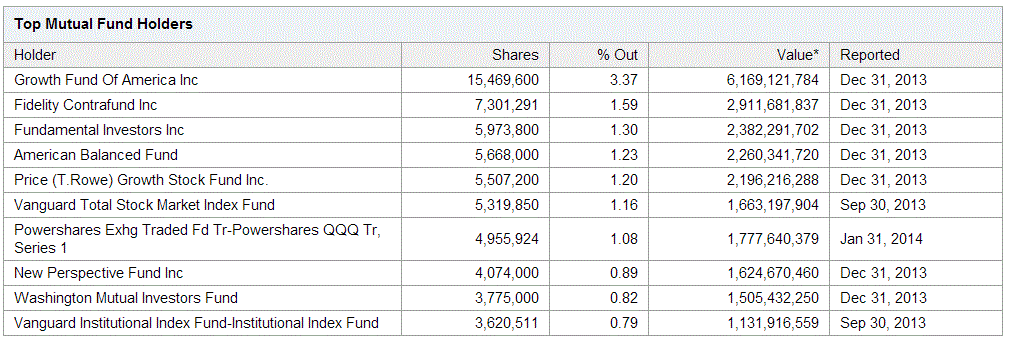Last year I said that not many would have thought in 1998 that this loss-making business would one day
sell at about $120 billion. Now Amazon is selling at $160 b; up 33%.
As we can see analysts have estimated it to sell at about $200 b in a year's time. That's a cool 25% upside when the T-bill rate is a fraction and T-bond rate is about 2.68%.
The stock had reached $408 in Jan-2014 and $245 in May-2013. For those who get excited about the timing game, it is a return of 66%.
Amazon has 459.26 m shares outstanding of which about 19.20% are held by the insiders and about 68.10% are held by the institutions.
The insiders:
The outsiders:
The price setters:
It is unlikely that Jeff Bezos and his team would trade frequently; and it is not possible for the holders of the balance 13% (collective ownership) of the stock to set prices in the market due to their small individual ownership. These shareholders are weak and scattered. Therefore, it is clear that the mischief-makers are the institutions who own the big chunk, have the ability to trade them, and frequently do trade them. They want to play both the timing and the expectations game.
Is Amazon worth $160 b?
To answer this we have to leave aside the games played by the market, and concentrate on the fundamentals of the business that the company is in.
While revenues have grown considerably over the last 5 years, there has been a notable deterioration in operating margins. This is definitely not a good news.
The company has $9.75 b of equity and about $4.50 b of debt including capital leases of $1.3 b, all at book values. It also has non-cancellable operating leases. Furthermore, Amazon has about $12.50 b of cash and marketable securities. Effectively, this translates into book operating capital of $1.75 b before capitalizing operating leases. Due to the low capital base, the return on capital appears to be more than adequate. Amazon is still doing good at least based on the current numbers.
Into the future for Amazon:
The key is how far can Amazon translate these current numbers into better numbers in the future. To justify the current market price for the stock this appears to be a daunting question.
Based on reasonable expectations we should get a far lower value for Amazon than what it is priced now.
At a price of $347 per share and market value of $160 b, the implied variables the market is currently assuming over the next 10 years are: an operating margin of 3%, a growth rate of 19.25% and a return on capital of 48%. After 10 years, the company is presumed to be in a stable growth mode.
Just to give an idea, at 19.25% growth rate the company would have revenues of $445 b in year 11, which is pretty close to Wal-Mart's revenues.
That has not stopped analysts from doing their job:
We should follow them at our own risk is an understatement, though.
What is long term?
The question to the managers, analysts and investors then is, what is long term when we look at Amazon as a business?






No comments:
Post a Comment